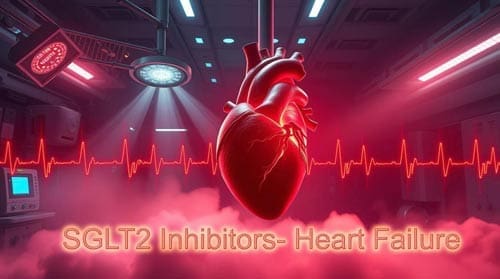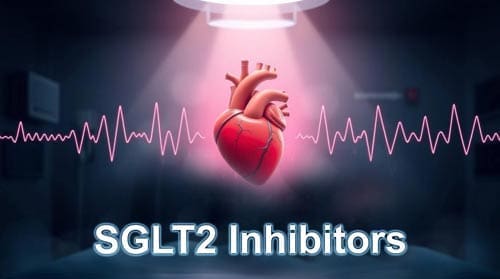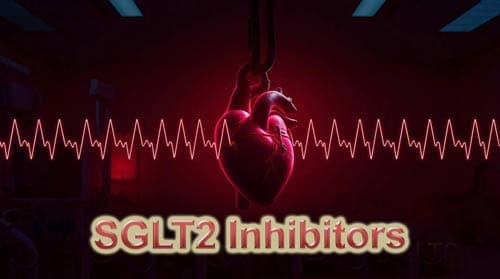SGLT2 Inhibitors in Heart Failure: New Evidence Changes Treatment Protocols
Quick video summary of the detailed article below.
Introduction
Heart failure is a global health challenge, affecting over 64 million people worldwide. It is a major cause of hospital stays and deaths. The five-year survival rate is just 25% for patients with reduced ejection fraction who need to be admitted. Managing heart failure is a tough challenge in cardiovascular medicine. Recent advancements, however, bring new hope. One of the biggest breakthroughs recently is the use of SGLT2 inhibitors. These drugs were first made to lower blood sugar for type 2 diabetes. Now, they show great benefits for heart failure patients, even if they don’t have diabetes.
SGLT2 inhibitors boost survival rates. They also cut down hospital visits for heart failure and improve heart health overall. In a study with 6,776 patients, those on these medications had a 25% lower risk of dying from any cause than those who didn’t receive treatment. Mortality rates decreased from 8.5 to 5.8 per 100 person-years. Additionally, hospitalizations for heart failure were reduced by up to 30%. These benefits appeared in major clinical trials. It includes the EMPEROR-Reduced trial, which focused on patients with chronic heart failure and reduced ejection fraction. It also includes the DAPA-HF trial, which looked at preventing bad outcomes in heart failure. These studies showed strong results. So, SGLT2 inhibitors are now part of standard heart failure treatment guidelines.
This article reviews new scientific evidence for SGLT2 inhibitors, describes how they function, and offers practical advice for using them in clinical practice.
The Emergence of SGLT2 Inhibitors in Heart Failure Treatment
The development of SGLT2 inhibitors represents a significant shift in cardiovascular medicine. These medications were first used to help control blood sugar in people with type 2 diabetes. However, they soon attracted attention for their surprising cardiovascular benefits. The first signs of heart protection appeared in the EMPA-REG OUTCOME study. This trial focused on Type 2 Diabetes Mellitus patients taking Empagliflozin. This trial demonstrated that empagliflozin reduced hospitalizations due to heart failure by 35% in patients with type 2 diabetes. Subsequent trials involving canagliflozin and dapagliflozin confirmed similar cardiovascular benefits in diabetic patients.
These findings prompted researchers to explore whether SGLT2 inhibitors could help heart failure patients, even if they don’t have diabetes. The results were groundbreaking. Studies showed that these treatments work well for many patients, including those with heart failure with reduced ejection fraction (HFrEF) and heart failure with preserved ejection fraction (HFpEF). They also benefit people with chronic kidney disease (CKD) and those without diabetes.

Key Findings from Clinical Trials
Several large clinical trials have proven the effectiveness of SGLT2 inhibitors in treating heart failure. The DAPA-HF trial was the first to examine whether or not these medications were used in heart failure patients and whether they had diabetes. The study found a 20–25% lower risk of being admitted to the hospital for heart failure or dying from heart problems.
The EMPEROR-Reduced trial also showed these benefits for patients with reduced ejection fraction. It confirmed that SGLT2 inhibitors improve heart failure outcomes reliably. A pooled analysis of both trials found that treatment with these medications resulted in:
A 13% reduction in death from any cause
A 14% reduction in cardiovascular-related mortality
A 31% reduction in hospital admissions due to heart failure
The EMPEROR-Preserved trial also found that empagliflozin helps patients with preserved ejection fraction in chronic heart failure. The trial showed a 21% lower risk of being hospitalized for heart failure or dying from cardiovascular issues. It confirms the importance of SGLT2 inhibitors for various heart failure types.
A review of 13 major clinical trials with over 90,000 patients showed that these medications consistently cut hospitalizations and boosted survival rates. It makes them essential for managing heart failure.
Changes in Treatment Guidelines
As a result of the compelling clinical evidence, treatment guidelines have evolved significantly. The 2022 guidelines from the American Heart Association (AHA), American College of Cardiology (ACC), and Heart Failure Society of America (HFSA) now recommend SGLT2 inhibitors. They are one of the four main therapies for heart failure. Specifically:
They are given a Class 1 recommendation for patients with HFrEF, meaning they should be used as a standard treatment.
A Class 2a recommendation is for people with heart failure and mildly reduced ejection fraction (HFmrEF). This means using SGLT2 inhibitors is reasonable and helpful.
Patients with HFpEF get a Class 2a recommendation. This shows the good results from clinical trials.
The American Diabetes Association (ADA) now recommends SGLT2 inhibitors for patients with type 2 diabetes, including those with heart failure or those at high risk of developing it. Dapagliflozin and empagliflozin are FDA-approved. These drugs are used to manage diabetes and reduce the risk of heart failure.
Implementing these guidelines marks a major shift in how heart failure is treated. Research shows that starting SGLT2 inhibitor therapy, plus other recommended medicines, may cut the risk of death by up to 73% for patients with reduced ejection fraction.
The rapid advancement of SGLT2 inhibitors demonstrates how unexpected scientific discoveries, combined with rigorous clinical research, can significantly improve patient care. As research continues, these medications remain essential to modern heart failure treatment, offering new hope for millions of individuals worldwide.

How SGLT2 Inhibitors Work in Heart Failure
The beneficial effects of sodium-glucose cotransporter-2 inhibitors go beyond lowering blood glucose levels. These medications work on several pathways in the heart. They help balance sodium and calcium in heart cells. They also reduce oxidative stress and stop too much calcium from building up. These mechanisms protect the heart from more damage. They also improve heart function, even in patients who don’t have diabetes.
Sodium-glucose cotransporter-2 inhibitors can lower left ventricular mass, help improve diastolic function, and help the heart use ketone bodies for energy. This is especially helpful in heart failure, where energy production is often weak.
Another key benefit is that it reduces abnormal diastolic tension in the heart. This helps improve relaxation and overall heart performance. Studies show that sodium-glucose cotransporter-2 inhibitors lower oxidative stress and inflammation. These factors contribute to heart failure progression. These effects lead to better exercise ability, fewer symptoms, and an improved quality of life for patients.
Patient Selection and Clinical Assessment
Sodium-glucose cotransporter-2 (SGLT2) inhibitors are effective in treating heart failure. Many clinical studies support their use in different patient groups. Identifying suitable candidates for therapy is crucial for optimizing therapeutic benefits and minimizing potential risks. Current clinical guidelines strongly endorse SGLT2 inhibitors for individuals with chronic heart failure, particularly those with reduced ejection fraction. Research shows that about 80% of heart failure patients qualify for treatment with these medications, according to the U.S. Food and Drug Administration.
Key eligibility criteria include a left ventricular ejection fraction of 40% or less for patients with heart failure and a reduced ejection fraction. People with preserved ejection fractions and those with levels above 40% can get treatment. You need an estimated glomerular filtration rate of at least 30 millilitres per minute for every 1.73 square meters. This ensures your kidneys work well. Patients should show symptoms that fit New York Heart Association functional class II to IV.
Studies show that SGLT2 inhibitors can help more patients. This includes those who have preserved ejection fraction, even with standard criteria. Interestingly, people with a 60% or higher ejection fraction show similar therapeutic effects to those with lower values. These findings suggest that limiting treatment to those with reduced ejection fraction might leave out patients who could gain important cardiovascular benefits.
Before initiating SGLT2 inhibitor therapy, a thorough clinical evaluation is essential. Doctors should check key lab results. This should include a complete blood count, renal function tests, blood glucose levels, and natriuretic peptides like N-terminal pro-brain natriuretic peptides. Cardiovascular assessment must include echocardiography. This checks left and right ventricular function and looks for valvular issues. It’s important to consider factors such as coronary artery disease, hypertension, diabetes, obesity, chronic lung disease, and prior exposure to cardiotoxic agents. These details help determine if therapy is right for the patient.
Although SGLT2 inhibitors provide substantial cardiovascular benefits, contraindications should be considered. These include high blood sugar that isn’t controlled, recent heart issues, stroke in the last few months, and active cancers being treated. Older people often get fewer prescriptions. However, clinical trials show they benefit from therapy as much as younger patients. So, age shouldn’t be a reason to exclude them from treatment. To ensure safety and effectiveness, close monitoring of blood pressure, glycemic control, renal function, and volume status is necessary following the initiation of therapy.

Starting SGLT2 Inhibitor Therapy
New clinical evidence shows that starting SGLT2 inhibitors early helps manage heart failure. Studies reveal major benefits can occur just days or weeks after beginning treatment. These medications follow a straightforward once-daily dosing regimen. Dapagliflozin is generally given at a starting dose of 5 milligrams per day. In contrast, empagliflozin is started at 10 milligrams each day. Sotagliflozin is another SGLT2 inhibitor. It starts at 200 milligrams per day. The dose can go up to 400 milligrams daily, depending on how well the patient tolerates it.
Timing plays a crucial role in optimizing treatment outcomes. Research indicates that benefits can become evident within 12 days of therapy initiation. Studies on empagliflozin show a 58% lower risk of death, heart failure, hospital stays, or urgent medical visits soon after starting treatment. Given these findings, clinicians should consider initiating SGLT2 inhibitors during hospitalization or immediately after discharge to maximize their therapeutic impact.
Regular monitoring is essential to ensure safe and effective treatment. Renal function should be assessed at baseline and periodically during therapy. An initial drop in the estimated glomerular filtration rate of 3 to 4 milliliters per minute per 1.73 square meters is expected. This decline usually stabilizes in one to three months. Volume status should also be monitored regularly, particularly in patients receiving concurrent diuretics. Adjustments to diuretic therapy may be necessary to prevent excessive volume depletion. Routine lab tests should include a metabolic panel, lipid profile, and renal function tests. These tests help track changes in serum creatinine, potassium, hematocrit, and bicarbonate levels.
SGLT2 inhibitors rarely have pharmacokinetic interactions. However, doctors need to review other medications to lessen the risk of side effects. Pay close attention to the risk of hypoglycemia in patients on insulin or sulfonylureas. There is also a chance of urinary tract infections and diabetic ketoacidosis. Patients with surgery or acute illness should stop SGLT2 inhibitors for at least three days. This helps reduce the risk of ketoacidosis.
Managing Common Side Effects
Effective management of side effects is crucial for heart failure patients taking SGLT2 inhibitors. It helps them stay on their therapy for the long haul. Urinary tract infections are a concern, but studies show low risk. Urinary tract infections occur in 3% to 9% of SGLT2 inhibitor users. Most cases are mild to moderate and usually do not require stopping treatment. Patients must understand the importance of hydration and hygiene to lower infection risks. Individuals who have frequent infections might need extra monitoring.
Volume depletion may be a worry because SGLT2 inhibitors can cause diuresis. Older adults or people with moderate kidney problems may experience symptoms like dizziness, low blood pressure, and orthostatic hypotension. Clinical studies show that the rate of volume depletion is similar for SGLT2 inhibitors and placebo. To prevent adverse effects, physicians should routinely assess blood pressure, monitor for signs of dehydration, and adjust diuretic therapy as needed.
Diabetic ketoacidosis is a serious but rare problem with SGLT2 inhibitors. It happens in about two out of every 1,000 patients treated. SGLT2 inhibitor-associated ketoacidosis is different from traditional diabetic ketoacidosis. While the latter has very high blood glucose levels, the former can show normal or slightly high glucose levels. This is called euglycemic diabetic ketoacidosis. Risk factors include prior episodes of ketoacidosis, poorly controlled diabetes, recent hypoglycemic events, and concomitant use of certain medications.
Healthcare providers need to stay alert in high-risk situations, including prolonged fasting, acute illness, and surgical procedures. Temporary discontinuation of SGLT2 inhibitors before major surgery or during significant metabolic stress can help prevent ketoacidosis. Patients should be educated on recognizing symptoms such as nausea, vomiting, fatigue, and abdominal pain, and they should seek immediate medical attention if these symptoms arise.

Combining with Other Heart Failure Medications
Current treatment strategies focus on combining sodium-glucose cotransporter-2 (SGLT2) inhibitors with heart failure medications. This approach aims to boost benefits and reduce side effects. A structured approach helps integrate these medications into treatment plans, ensuring patients get the most benefit quickly and safely.
Sequencing of Therapies
Recent advances in heart failure treatment show that starting basic therapies early is very important. In the past, adding several medications could take months, often delaying the full benefits of therapy. However, a newer approach aims to establish comprehensive treatment within four weeks, leading to better patient outcomes.
The recommended sequence begins by simultaneously initiating a beta-blocker and an SGLT2 inhibitor. This early intervention stabilizes heart function and prepares the patient for further therapies. Sacubitril/valsartan is started within one to two weeks. Blood pressure must be closely monitored to keep the patient safe. By week four, a mineralocorticoid receptor antagonist is added. Kidney function and potassium levels are still monitored closely.
This fast approach is backed by clinical evidence. Each of these medications shows real benefits within 30 days of starting. Studies show that even small doses can lead to big improvements. This quick strategy is both safe and effective.
Drug Interaction Considerations
SGLT2 inhibitors usually have few interactions with other heart failure drugs. However, some combinations need extra care. SGLT2 inhibitors boost diuretic effectiveness when used with diuretics without raising the risk of kidney damage. Close monitoring of fluid levels is important, especially when using loop diuretics. Dose adjustments may be needed.
Pharmacokinetic studies show that most SGLT2 inhibitors do not significantly affect statin levels. However, canagliflozin shows the highest interaction potential, and dapagliflozin slightly increases exposure to simvastatin.
No significant interactions have been observed between SGLT2 inhibitors and valsartan or warfarin. Canagliflozin raises digoxin levels. So, it’s important to monitor these levels regularly when using both drugs together. Combining SGLT2 inhibitors with insulin or insulin secretagogues can increase the risk of hypoglycemia. This means dose adjustments may be needed, and blood glucose should be checked often.
Despite variations in background therapy doses, SGLT2 inhibitors consistently demonstrate efficacy. Clinical trials indicate that these medications are effective. They work well for patients taking full or reduced doses of other heart failure drugs. Therefore, their use can be tailored to individual patient needs without compromising effectiveness.
Practical Considerations for Optimal Therapy
Successful integration of SGLT2 inhibitors into heart failure treatment requires careful monitoring of several key factors. Doctors must often check blood pressure, kidney function, electrolyte levels, and fluid status to ensure patients handle the medication well. Glycemic control should also be closely monitored for individuals with diabetes.
Research shows that starting SGLT2 inhibitors during hospitalization is safe. Patients should meet certain criteria: stable blood pressure above 100 mmHg, no recent changes in vasodilator therapy, and no inotropic support in the last 24 hours.
The benefits of treatment appear independent of other medications. For example, the effectiveness of mineralocorticoid receptor antagonists remains unchanged when angiotensin receptor-neprilysin inhibitors are used. Likewise, SGLT2 inhibitors provide cardiovascular benefits regardless of the patient’s background therapy. This flexibility allows for individualized treatment plans based on patient-specific responses and conditions.
Measuring Treatment SuccessMeasuring Treatment Success
Healthcare providers check clinical markers and patient feedback to see how well SGLT2 inhibitors work for heart failure. A systematic approach enables personalized treatment adjustments to optimize benefits.
Clinical Response Markers
NT-proBNP levels are important for tracking therapy response. Patients on SGLT2 inhibitors show a significant decrease in these levels. Studies have shown an average reduction of 136.03 pg/mL, reflecting improved heart function. Other important cardiac function improvements include increased left ventricular ejection fraction, reduced left ventricular mass index, decreased left ventricular end-systolic volume, and improved left atrial volume index.
Doctors also monitor changes in NYHA functional classification and track heart failure hospitalizations, cardiovascular mortality rates, and kidney function. Research shows that SGLT2 inhibitors lower the risk of heart failure hospitalizations by 31%, proving their lasting clinical benefits.
Quality of Life Improvements
Patient-reported outcomes offer valuable insights into the real-world impact of SGLT2 inhibitors. Studies show that using tools like the Kansas City Cardiomyopathy Questionnaire (KCCQ) greatly improves the quality of life in many areas. Patients taking SGLT2 inhibitors see quick improvements. They notice better symptoms, physical function, and daily activities. Most progress happens in the first two weeks of treatment. These benefits last over time, no matter the patient’s age, diabetes status, or ejection fraction.
Exercise Capacity Changes
SGLT2 inhibitors have been shown to improve exercise capacity in heart failure patients. These enhancements are consistent across different patient subgroups, including those with heart failure with reduced ejection fraction and preserved ejection fraction and diabetic and non-diabetic individuals. Improved functional capacity results in better long-term outcomes and increased survival rates.
Special Patient Populations
SGLT2 inhibitors offer benefits to many patient groups, including elderly individuals, those with kidney disease, and even non-diabetic patients. Research shows that older adults tolerate these medications well. There is no significant rise in fracture risk or volume depletion. Research shows that SGLT2 inhibitors protect the kidneys. This is true even for patients with an estimated glomerular filtration rate as low as 20 mL/min/1.73 m².
SGLT2 inhibitors offer major heart benefits for non-diabetic people with heart failure. They lower the chances of being hospitalized for heart issues and reduce the risk of death. These medications also help improve metabolic factors like body weight and blood pressure.

Conclusion
SGLT2 inhibitors represent a breakthrough in heart failure treatment, delivering substantial benefits across multiple patient groups. Clinical evidence shows they can lower death rates, cut hospital stays, boost quality of life, and increase functional capacity. These benefits stay the same regardless of ejection fraction, diabetes, age, or other treatments. Rapid and comprehensive implementation of SGLT2 inhibitors alongside other foundational heart failure medications leads to optimal patient outcomes.
Frequently Asked Questions:
FAQs
Q1. What are the latest treatment options for heart failure in 2023? Recent approvals by the FDA have expanded heart failure treatment options. Dapagliflozin and sotagliflozin, an SGLT1/2 inhibitor, got approval in May 2023. They are now approved for treating heart failure at various left ventricular ejection fraction levels.
Q2. How should SGLT2 inhibitors be used in heart failure patients? These medications are typically taken once daily. Stop them temporarily before surgery, during prolonged fasting, or when critically ill. This helps reduce the risk of ketoacidosis. Most SGLT2 inhibitors, except for canagliflozin, can be taken with or without food.
Q3. Which SGLT2 inhibitors are most effective for heart failure? Empagliflozin, dapagliflozin, and sotagliflozin have shown significant benefits. They reduce hospitalization and mortality risks, slow kidney disease progression, and improve symptoms. Empagliflozin is the most commonly used option. Dapagliflozin was the first one approved to lower hospitalizations due to heart failure.
Q4. What precautions should be taken when using SGLT2 inhibitors during illness? If you’re feeling unwell with vomiting, diarrhea, or not eating and drinking enough, you should stop taking SGLT2 inhibitors. This helps prevent ketoacidosis and severe dehydration.
Q5. How do SGLT2 inhibitors benefit non-diabetic heart failure patients? SGLT2 inhibitors lower the risk of dying from heart issues and hospital stays for non-diabetic heart failure patients. They also improve metabolic health with few side effects.
References:
Provided on request.

